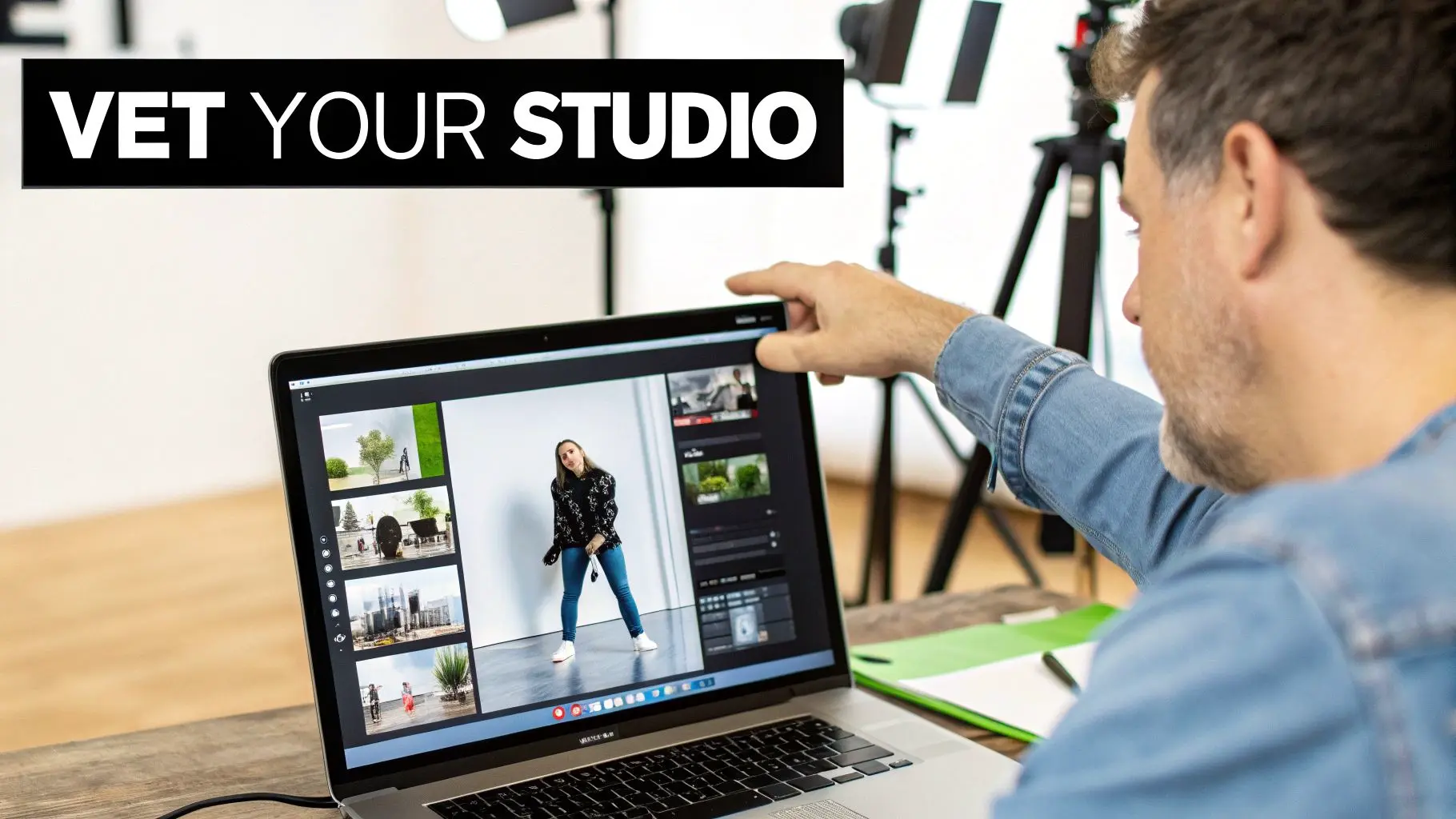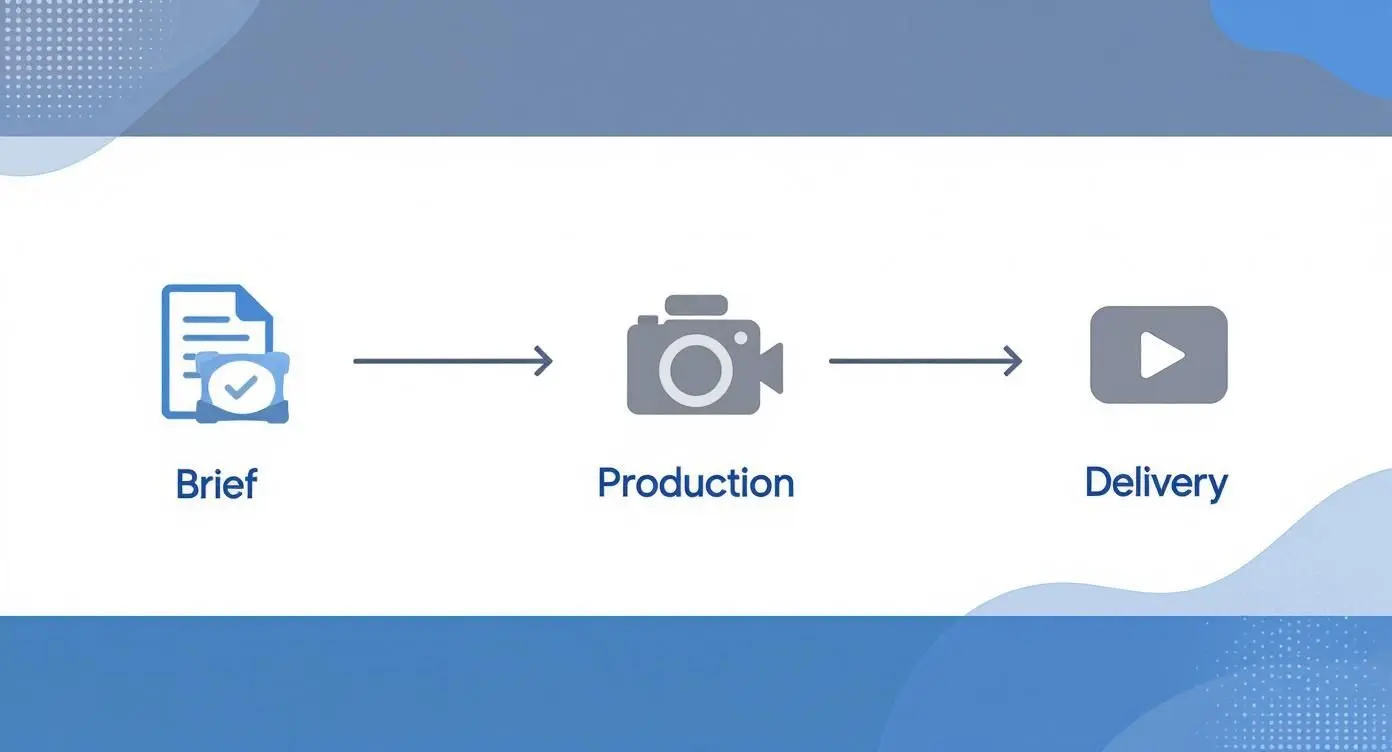Explainer Videos for Complex Tech: Storyboarding Clarity for Hard-to-Explain Products
An explainer video production company does exactly what it says on the tin: it creates short, engaging videos that break down complex ideas, products, or services for a specific audience. In a world where visual content is king, these videos have become a go-to tool for businesses wanting to grab attention, increase conversions, and build genuine trust with their customers.
The Strategic Value of Explainer Videos

Let's look at the numbers. Heading into 2025, video content is the most crucial format for digital marketers in the UK. A recent study found that 73% of video marketers named explainer videos as their single most-used format. This isn't just a fleeting trend; it’s a massive shift from the days when TV ads were the only game in town. Today, everyone from SaaS start-ups to established healthcare providers are investing in animated explainer videos to clarify what they do and fuel their growth. Discover more insights about video marketing statistics and see just how dominant the format has become. But explainer videos are more than just a marketing box to tick. They are a serious strategic asset that delivers real, measurable results. Think of them as a versatile communication tool that works hard for you at every stage of the customer journey, from that first flicker of awareness right through to post-purchase support.
Clarifying Complex Products and Services
Ever tried explaining a sophisticated software platform or a complex financial product using only text? It’s tough. An explainer video can slice through that complexity, turning intricate concepts into a simple, visual story that’s easy to follow. A fintech company, for instance, can use a 90-second animation to show precisely how its app makes international payments a breeze, a process that would take pages of dry text to describe. This clarity doesn't just educate potential customers; it also takes a significant load off your customer support team. The smart use of engaging visuals, which we explore in our guide on why motion graphics are essential for businesses, is the secret sauce here.
Boosting Engagement and Conversions
Static landing pages often struggle to keep a visitor’s attention for more than a few seconds. Pop an explainer video at the top of a key page, however, and you can see your dwell time shoot up, guiding visitors toward that all-important call to action.
By simplifying the value proposition and showing a product in action, a well-crafted explainer video can directly impact conversion rates, turning passive browsers into active leads and loyal customers.
To really make this work, you need a solid understanding of core branding principles. After all, these videos are a direct reflection of your brand identity. A professional explainer video production company ensures everything aligns perfectly, creating content that isn't just informative but is also a flawless expression of your brand’s personality and values. That’s what makes partnering with a studio a strategic investment in growth, not just another marketing expense.
Building a Brief That Attracts the Best Studios

Before you even think about shortlisting an explainer video production company, the most important work actually starts with you. The secret weapon? A clear, detailed creative brief. It’s far more than just a document; it’s the strategic tool that will communicate your vision and, crucially, attract the high-calibre studios you actually want to work with. Think of a strong brief as your project’s North Star. It ensures everyone involved, from your own team to the animators, is aligned from the get-go. Without that clarity, you’re just inviting wasted time and money on concepts that completely miss the mark. A well-crafted brief, on the other hand, gives a studio everything they need to deliver a video that genuinely hits home and smashes your goals.
Defining Your Audience and Core Message
First things first, you need to get incredibly specific about who you're trying to reach. "Everyone" is not a target audience. Are you talking to C-suite executives who only care about the high-level ROI, or are you trying to help daily software users understand a new feature? The entire tone, language, and visual style will shift dramatically depending on the answer. Next, you have to nail down your core message. I know you’ve got a dozen things you could say about your product, but what is the one single thing your audience absolutely must remember after watching? This singular focus is what makes an explainer video impactful and memorable. Your job is to distil your entire value proposition into one simple, compelling statement.
A great brief doesn't just list features; it articulates the problem your product solves and the transformation it offers the user. This focus on the "why" is what separates a forgettable video from one that genuinely connects.
Setting Clear Goals and KPIs
So, how will you know if the video was a success? Vague goals like "increase brand awareness" are almost impossible to track and are pretty meaningless to a creative team. Instead, you need to set specific, measurable key performance indicators (KPIs) that tie directly back to your business objectives. Your goals could look something like this:
- •Increase landing page conversions by 15%.
- •Reduce customer support tickets on a specific topic by 20%.
- •Improve lead quality by pre-educating prospects before they talk to sales.
Giving a production company concrete metrics like these gives them a clear target to aim for. It empowers them to make strategic creative decisions, from the script to the final call-to-action, all designed to help you hit those numbers. To get all your ducks in a row, you’ll want to master your video brief using a solid template. This groundwork means you can approach any explainer video production company with total strategic clarity, ready to build a powerful partnership from day one.
How to Properly Vet a Production Company

Alright, you’ve got your creative brief locked down. Now for the exciting part: finding the perfect production partner. A slick showreel is a great first impression, but it's just that, an impression. To really know if a company is the right fit, you need to dig a bit deeper. Choosing a studio is a big deal. You’re not just buying a video; you’re starting a creative partnership. You need a team that doesn't just make pretty pictures but understands your goals and can deliver real results. It’s about looking past the shiny portfolio to see if they have the strategic chops to bring your vision to life.
Analysing Portfolios With a Critical Eye
It’s easy to be wowed by one amazing video, but a strong portfolio shows both consistent quality and, crucially, variety. You need to look for work that actually lines up with what you need. If you're selling complex B2B software, a portfolio packed with live-action ads for fizzy drinks probably isn't the best match, no matter how cool they look. As you browse, keep an eye out for a few specific things:
- •Industry Relevance: Have they worked in your sector before? If they have, it’s a good sign they’ll get up to speed quickly and understand the nuances of your audience.
- •Stylistic Versatility: Can they do more than one thing well? Look for a range of styles like 2D, 3D, and motion graphics. A studio with a broad toolkit can find the perfect visual language for your brand.
- •Strategic Storytelling: Do their videos feel like a checklist of features, or do they tell a story? The best explainer videos aren't just informative; they're persuasive. Look for a clear narrative that presents a problem and offers a compelling solution.
This kind of focused review helps you filter out the studios that look the part but don’t have the specific experience your project demands.
Questions to Uncover Their Production Process
Once you have a shortlist, it’s time to find out how they actually work. The right questions will tell you everything you need to know about their professionalism, communication style, and how they manage projects. A clear, well-defined process is the hallmark of a reliable partner. Don’t just ask, "What’s your process?" Get specific.
- Scripting and Storyboarding: Who handles the script? How many rounds of feedback do you get? Will you see a full storyboard before a single frame is animated?
- Voiceover and Sound Design: Do they handle casting the voiceover artist, or is that on you? How do they choose and license music?
- Communication and Project Management: Who will be your day-to-day contact? What tools do they use for feedback? How often will you get updates?
Production Company Evaluation Checklist
This table is a simple tool to help you compare studios side-by-side and spot any potential issues before you commit.| Evaluation Criterion | What to Look For | Red Flags to Avoid |
|---|---|---|
| Portfolio Quality | High-quality, polished videos that show creativity and technical skill. | Inconsistent quality, outdated styles, or a lack of relevant examples. |
| Industry Experience | Previous work with clients in your sector or a similar field. | A portfolio completely unrelated to your industry or audience. |
| Communication | Clear, prompt, and professional responses. A designated point of contact. | Slow replies, vague answers, or being passed between multiple people. |
| Process Transparency | A well-defined production process with clear stages for feedback and approval. | Hesitancy to explain their workflow or a process that seems disorganised. |
| Client Testimonials | Positive reviews and case studies that highlight their process and results. | No testimonials, or vague reviews that don't mention specific outcomes. |
| Pricing Structure | A clear, itemised quote that explains all costs. No hidden fees. | Unusually low prices, reluctance to provide a detailed quote, or high-pressure sales tactics. |
Be wary of any studio that is hesitant to share detailed case studies, seems vague about their pricing structure, or pressures you into a decision without a clear scope of work. These are significant red flags that could point to a lack of experience or transparency.By taking this measured approach, you shift from simply buying a service to actively choosing a creative partner. It sets the stage for a smooth collaboration and, ultimately, a video that gets the job done.
Understanding Timelines and Budgets
Let's get down to the two questions everyone asks first: "How much is this going to cost?" and "When can I have it?" The honest answer? It depends. There's no one-size-fits-all price list for a quality explainer video. The final investment and the time it takes to create it hinge on a few key factors. Getting your head around these will help you set a realistic budget and know what to expect from the process. Think of it like building a custom piece of furniture. A simple pine bookshelf won't have the same price tag or build time as an ornate, hand-carved oak wardrobe. The same principle applies here , the complexity and craftsmanship involved are what really drive the final numbers.What Really Shapes Your Video Budget?
When you start getting quotes from production companies, you'll see a few core elements that consistently influence the price. Understanding these will put you in a much better position to have a productive conversation with any studio you talk to.- •Animation Style: This is easily the biggest variable. A clean, 2D motion graphics video is typically less labour-intensive than a bespoke piece with custom-animated characters. And if you're looking at complex 3D animation, which involves modelling, rigging, and detailed lighting, you're at the top end of the cost spectrum.
- •Video Length: It might seem straightforward, but it's more than just the final runtime. A longer video means more time spent on everything: scriptwriting, storyboarding, animating, and sound design. Most studios will price their work per minute, but the density of what happens within that minute is just as important.
- •Voiceover and Sound: Do you need a recognisable voice actor, or would a professional studio artist be a better fit? An artist's experience and profile will directly affect the cost. It’s the same with music; commissioning a custom track is a bigger investment than licensing a fantastic one from a music library.
By understanding what drives the cost, you can make strategic decisions. If you have a tighter budget, you might go for a shorter video using slick motion graphics and a licensed track. You can still get a powerful, high-quality result without compromising your core message.
So, What Should You Actually Expect to Pay?
Let's talk numbers. For a professionally produced explainer video in the UK, you're typically looking at a range between £6,000 and £15,000+ for the full project. Drilling down further, per-minute rates for top-tier work can go anywhere from £4,000 to £15,000. Many experienced studios, however, tend to average around £5,500 to £6,500 per minute. As for timelines, most agencies can deliver a standard project in three to four weeks. Of course, more intricate videos with several rounds of feedback can naturally extend this. You can learn more about the factors that drive video pricing and see how these figures stack up against what you have in mind. A typical project schedule isn't just a black box; it follows a clear, multi-stage path:
- Discovery & Scripting (1 week): Kicking things off with initial meetings, brainstorming concepts, and locking down the script.
- Storyboarding & Design (1 week): This is where we define the visual style and create a scene-by-scene storyboard for you to sign off on.
- Animation & Production (1-2 weeks): The most intensive part of the process, where our animators bring the visuals to life.
- Sound Design & Final Delivery (1 week): Mixing the voiceover, music, and sound effects, then rendering and delivering the final video files to you.
Managing the Production Process for a Great Result
Right, you’ve picked your explainer video production company. That’s a huge step, but now the project’s success depends on something new: collaboration. A truly great video isn’t just made for you; it’s made with you. How you engage with the production team from here on out will directly shape the schedule, budget, and the quality of the final cut. This visual timeline gives you a bird's-eye view of the typical journey, from the initial brief right through to the final delivery. Think of each stage as a critical checkpoint. It’s where your input is absolutely essential to keep the wheels turning and the project moving forward without a hitch. This kind of collaborative spirit is what makes the UK's creative sector thrive. The post-production industry alone, which includes many animation studios, is on track to hit an estimated £1.5 billion in revenue by 2025. With government initiatives aimed at boosting investment, the quality and capacity of UK studios are only going to get better.
Think of each stage as a critical checkpoint. It’s where your input is absolutely essential to keep the wheels turning and the project moving forward without a hitch. This kind of collaborative spirit is what makes the UK's creative sector thrive. The post-production industry alone, which includes many animation studios, is on track to hit an estimated £1.5 billion in revenue by 2025. With government initiatives aimed at boosting investment, the quality and capacity of UK studios are only going to get better. Providing Clear and Consolidated Feedback
If there's one thing you can do to be a dream client, it’s providing feedback that is both clear and consolidated. Forget sending a flurry of separate emails with conflicting notes from different team members. It’s a recipe for confusion. Instead, gather all comments into a single, organised document. This saves the production team from playing detective, trying to piece together contradictory requests. Be specific. "I don't like the colour" isn't helpful. "Can we use our primary brand blue for the background in scene three?" is exactly what they need.Here’s a classic real-world scenario: The storyboard is with you for review. Most of your team has given it the thumbs-up, but then a key stakeholder swoops in with a major change request. The best way to handle this is to immediately flag it with the studio, have an open chat about how it might affect the timeline, and work together on a solution. Simply expecting a last-minute change to happen without any consequences is a fast track to delays.
Respecting Key Sign-Off Stages
The production process is built on key milestones for a very good reason. Signing off on the script, storyboard, and design proofs are firm commitments. They lock in creative decisions so the team can move on to the next phase with confidence. Trying to make changes after these stages can cause serious delays and budget headaches.- •Script Sign-Off: This confirms the story, messaging, and voiceover text are final.
- •Storyboard Approval: This locks in the visual sequence, camera angles, and any text on screen.
- •Design Lock: This finalises the character designs, colour palettes, and the overall look and feel.
Part of being a great partner is also trusting the studio’s expertise. Your input is vital, of course, but you hired this team for their years of experience in storytelling and visual communication. If they advise against an idea because it might clutter the message or kill the pacing, it's usually wise to listen. This balanced approach, your product knowledge combined with their creative skill, is what creates a true partnership. By working together effectively, you’ll not only keep the project on track but also end up with an outstanding final video. For more details on what studios can offer, explore our full range of professional animation services.
Frequently Asked Questions
Stepping into the world of explainer videos often leaves you with more questions than answers. Here, we’ve gathered the most common ones to help you cut through the clutter and move forward with confidence.
How Long Should an Explainer Video Be
From my experience, aiming for 60 to 90 seconds strikes the perfect balance between clarity and engagement. That timeframe lets you cover essential points without losing your viewers’ attention. Keep in mind that 91% of consumers watch explainer videos to get a quick overview. If your topic demands more depth, consider a short series instead of one lengthy film.
What Is the Difference Between 2D and 3D Animation
Choosing an animation style influences both your budget and the final appearance. Here’s a side-by-side look:
- •2D Animation
Works on the x- and y-axes like classic cartoons. It’s generally faster and more cost-effective, ideal for stylish motion graphics and straightforward storytelling.
- •3D Animation
Adds the z-axis for real depth and volume. Though more complex and resource-intensive, it delivers a premium, lifelike result, perfect for product demos or architectural visualisations.
Can I Provide My Own Script
Absolutely. You know your product inside out, and starting with your draft is a huge advantage. A reputable studio will refine your script, tightening language, smoothing transitions and syncing every line to the visuals. Think of it as a collaboration: your expertise plus their storytelling craft equals a standout video.
A script written for reading seldom works when spoken. A seasoned production team will transform your words into a natural, compelling voice-over narrative.
What File Formats Will I Receive
Once your project wraps up, you’ll get multiple deliverables tailored to various platforms. Typically, you’ll receive:
- •High-res .MP4 , Universally compatible with websites, presentations and social channels
- •Square (1:1) or Vertical (9:16) , Optimised for feeds and Stories
- •Compressed Version , Faster loading on your website
- •Master File , Your original, high-quality archive
Let us know your intended channels up front, and we’ll make sure you get exactly what you need. Ready to turn your complex ideas into a clear, compelling storyboard? Send us your pitch deck for a complimentary storyboard outline. Our team has been creating award-winning animation and digital content since 1996. Book a production scoping call with us today.